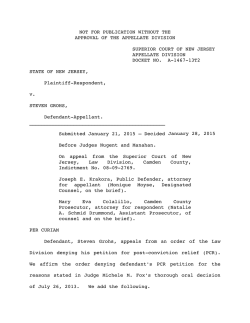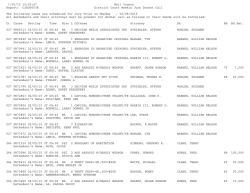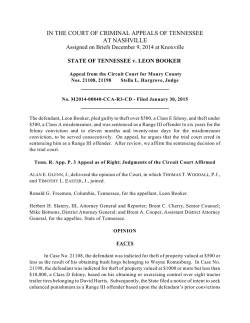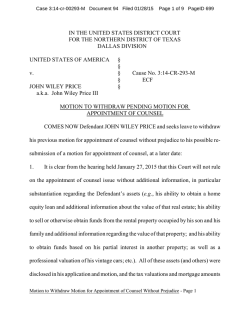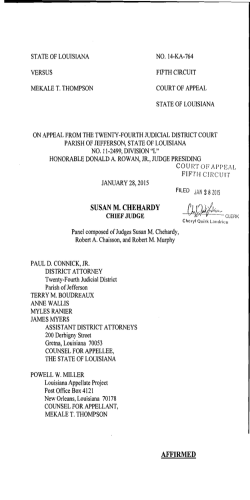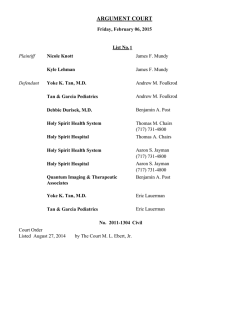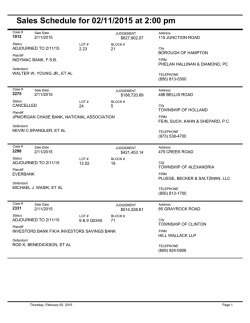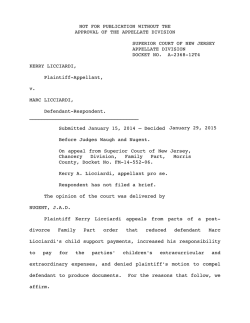
People v. Harris 2015 IL App (5th) 110151-U
NOTICE Decision filed 02/02/15. 2015 IL App (5th) 110151-U text of this decision may be changed or corrected prior to NO. 5-11-0151 Supreme Court Rule 23 and may not be cited as precedent the filing of a Peti ion for Rehearing or the disposition of NOTICE This order was filed under The IN THE the same. by any party except in the limited circumstances allowed under Rule 23(e)(1). APPELLATE COURT OF ILLINOIS FIFTH DISTRICT ________________________________________________________________________ THE PEOPLE OF THE STATE OF ILLINOIS, ) Appeal from the ) Circuit Court of Plaintiff-Appellee, ) St. Clair County. ) v. ) No. 08-CF-1477 ) RAYMOND HARRIS, ) Honorable ) Milton S. Wharton, Defendant-Appellant. ) Judge, presiding. ________________________________________________________________________ JUSTICE CHAPMAN delivered the judgment of the court. Presiding Justice Cates and Justice Goldenhersh concurred in the judgment. ORDER ¶1 Held: The defendant was not deprived of his right to a fair trial under the sixth amendment when the court in a bench trial found the defendant guilty on a theory of accountability where the only evidence linking the defendant to the crime was his own admission that he and two others went to the victim's home to confront the victim while armed and the prosecutor argued accountability as an alternative theory during the State's closing argument. ¶2 The defendant, Raymond Harris, appeals his conviction for murder after a bench trial. The defendant admitted to police that he went to the home of the victim with his brother and a friend to confront the victim about a matter involving the defendant's brother. He admitted that all three were armed. He did not, however, explicitly admit that any of them actually shot the victim. The court found that the evidence was not 1 sufficient to prove beyond a reasonable doubt that the defendant was the person who pulled the trigger; however, the court found that the evidence was sufficient to prove the defendant guilty under a theory of accountability. On appeal, the defendant argues that the court deprived him of his right to a fair trial under the sixth amendment by accepting this theory after it was inserted into the case after the close of evidence. We affirm. ¶3 On the morning of October 6, 2008, Amarian Williams was shot to death on the front porch of his mother's home. His mother, Beverly Williams, found him. In a statement to police shortly after the murder, Ms. Williams stated that after taking her younger children to school that morning, she went back to bed and asked Amarian to wake her up at noon. However, she awoke to the sound of the front door opening and closing. Shortly thereafter, she heard three gunshots. When Ms. Williams went outside to see what happened, she found Amarian on the porch, slumped over. He was unresponsive. Ms. Williams saw that Amarian was bleeding from his head. She saw a single vehicle speeding away, but did not see anyone else in the vicinity. ¶4 Nearly two months later, on November 25, 2008, the defendant was arrested on an unrelated warrant. He was also wanted for questioning in the murder of Amarian Williams. The arresting officers found the defendant hiding in a closet. When they got him out of the closet, they noticed that he was limping. Asked if he was injured, the defendant said that he had been shot a few days earlier. He was transported to St. Louis University Hospital. ¶5 The following day, the defendant gave a video-recorded interview to police in his hospital room. The defendant admitted that he went to the Williams home on the 2 morning of the murder with Douglas Griggs and Jaron Jamison. Griggs is the defendant's younger brother. He explained the reason he went to Amarian's house that morning as follows: "I just heard that he fucked with my little brother, man." He also indicated that they wanted to retrieve a shotgun belonging to Jamison that they believed Williams had in his possession. The defendant told the police that he and Griggs both had guns in their truck. The defendant's gun was a nine-millimeter Ruger. He did not know what type of gun Griggs had. ¶6 When one of the officers asked the defendant if his brother shot Amarian, the defendant said "No." When asked if Jaron Jamison shot Amarian, the defendant stated that Jamison did not shoot him either. The officer then stated, "So your brother didn't shoot and Jaron didn't shoot. That only leaves one other person." The defendant responded, "I ain't gonna say on camera that I shot anybody." The defendant further stated that he did not want to "get anybody in trouble." He admitted that he threw his gun off the Eads Bridge a few days later. ¶7 On December 9, 2008, the defendant was charged with first-degree murder in the death of Amarian Williams. The criminal complaint alleged that the defendant caused Amarian's death by shooting him in the head. It did not allege that the defendant was responsible for the conduct of Douglas Griggs or Jaron Jamison. ¶8 The defendant waived his right to a jury trial, and the matter came for a bench trial in October 2010. The parties stipulated that Beverly Williams would testify consistently with her statement to police, and that statement was read into evidence. In addition, the recording of the defendant's interview with police was played for the court. 3 ¶9 Two East St. Louis detectives testified to the circumstances surrounding the defendant's arrest. Detective Kenneth Berry testified that police had been unable to locate or contact the defendant in the weeks following the murder of Amarian Williams. As noted previously, the defendant was not arrested until November 25, 2008, which was approximately seven weeks after the murder. Detective Berry testified that police received an anonymous tip telling them where the defendant could be found. Detective Andre Hanson testified that "about ten" officers were present when the defendant was arrested. He further testified that when they found the defendant, he was hiding in a closet. The defendant initially denied being Raymond Harris. According to Detective Hanson, when an officer asked where Harris could be found, the defendant told officers that Harris "had just left." ¶ 10 Detective Berry testified about the circumstances surrounding the defendant's video-recorded statement. He testified that three officers were present. Prior to beginning the interview, one of the officers asked the defendant if he was under the influence of any medication, and the defendant said that he was only taking antibiotics. Detective Berry acknowledged that the defendant was scratching himself during the interview and was receiving some type of medication intravenously. However, Detective Berry testified that the defendant appeared to be coherent and did not seem to be impaired by medication. ¶ 11 Ronald Locke, a forensic scientist specializing in firearms and tool mark identification, testified for the State. Locke examined a bullet recovered from the exterior door frame of the Williams home and a bullet and two fragments recovered from 4 Amarian Williams during the autopsy. He explained that while it was not possible for him to determine whether the bullets were fired from any specific gun in this case, he was able to determine what class of gun could have fired the bullets. Locke determined that both bullets were fired from a 9-millimeter, .38-caliber gun. He testified that the two fragments could not be identified. ¶ 12 In closing arguments, the State argued that even though the defendant refused to explicitly say he pulled the trigger, he essentially confessed to being the shooter. The prosecutor pointed out that the defendant admitted going to the Williams home to confront Williams while armed. Additionally, he pointed out that the defendant told police that neither Griggs nor Jamison shot Amarian Williams, "thereby, by process of elimination, making him the shooter." The prosecutor further argued that the fact that the defendant threw his gun into the river also demonstrates that the defendant was the shooter. However, he also argued, "Under [the defendant's] version of events, your Honor, even if this Court didn't believe that he was the one that pulled the trigger, I would submit to the Court that under a theory of accountability" the defendant would be accountable for the actions of Griggs or Jamison. ¶ 13 Defense counsel argued that the defendant's vague statements about who pulled the trigger did not amount to a confession that he had done so. She argued that the defendant simply refused to name the shooter, pointing out that he said, "I don't want to get anybody in trouble." Defense counsel did not respond to the State's argument that the defendant might be found guilty under a theory of accountability. 5 ¶ 14 The court announced its findings from the bench. The court first noted that the defendant was aware that he was the focus of the investigation into Amarian Williams' murder when he gave his statement to police. The court went on to note that, in his statement, the defendant "absolve[d] other individuals from responsibility for the victim's death without stating directly that he was responsible." The court found that this was "not [a] conclusive admission or a conclusive denial." ¶ 15 The court found, however, that there was "clear evidence" of concerted action on the part of the defendant, Griggs, and Jamison. The court emphasized the evidence that the defendant and two others armed themselves and went to the Williams house to confront Amarian Williams. The court noted that Beverly Williams did not hear any argument or struggle–she only heard the door open and close a single time followed by three gunshots. The court found this to be evidence that the defendant, Griggs, and Jamison "came to that house with a common purpose, and that purpose was to kill the victim." The court also highlighted the fact that Beverly Williams saw a single vehicle leaving the scene at a high rate of speed and did not see any individuals attempting to flee on foot. The court reasoned that the fact that the suspects fled together showed that they were engaged in a common plan. ¶ 16 The court concluded that the evidence was not sufficient to prove beyond a reasonable doubt that the defendant "directly pulled the trigger." However, the court did find the evidence sufficient to prove beyond a reasonable doubt that the defendant was guilty under a theory of accountability. 6 ¶ 17 The defendant filed a motion for a new trial, arguing that the evidence was insufficient to support the defendant's conviction either as a principal or based on a theory of accountability. At a hearing on the motion, defense counsel first noted that to support a finding of guilt by accountability, the State must show that the defendant (1) has the intent to facilitate the commission of the offense before or during the crime; and (2) knowingly solicits, aids, or agrees to the commission of the offense. See People v. Taylor, 164 Ill. 2d 131, 140 (1995). Counsel then argued that the evidence in this case did not show that the defendant and the other two men went to Amarian Williams' home with any felonious intent. The court denied the motion and subsequently sentenced the defendant to 30 years in prison. The defendant filed a motion to reduce his sentence, which the court denied. This appeal followed. ¶ 18 The defendant argues that the court's decision to find him guilty on a theory of accountability violated his sixth amendment right to a fair trial because this theory was first addressed during the State's closing argument, after evidence was closed and both parties rested. The State argues that the defendant forfeited this argument by failing to object at trial or raise it in his posttrial motion. ¶ 19 Ordinarily, to preserve an issue for appeal, a defendant must raise that issue before the trial court both by making a contemporaneous objection and by raising the claim in a posttrial motion. Otherwise, the issue is forfeited. People v. Enoch, 122 Ill. 2d 176, 186 (1988). However, forfeiture is a limitation on the parties, not the court. People v. Hood, 2014 IL App (1st) 113534, ¶ 22. Moreover, under the plain error doctrine, appeals courts may relax the forfeiture doctrine where (1) the evidence is closely balanced or (2) the 7 error is so fundamental that it affected the fairness of the defendant's trial and undermined the integrity of the judicial process. People v. Herron, 215 Ill. 2d 167, 186-87 (2005). The error the defendant alleges here is fundamental. We will therefore address his contentions. ¶ 20 The sixth amendment to the United States Constitution provides several protections for criminal defendants, two of which are implicated here. The amendment guarantees a defendant the right to be clearly informed of the nature of the charges against him and the right to the assistance of counsel. U.S. Const., amend. VI. The right to be informed of the nature of the charges requires sufficient notice to allow the defendant to prepare a defense. Sheppard v. Rees, 909 F.2d 1234, 1236 (9th Cir. 1989) (citing Cole v. Arkansas, 333 U.S. 196 (1948)). The right to counsel includes the right to have counsel make an effective closing argument. People v. Millsap, 189 Ill. 2d 155, 164 (2000). The defendant acknowledges, as he must, that a defendant charged only as a principal may be convicted under a theory of accountability so long as the evidence supports this theory. This is because "accountability is not a separate offense, but merely an alternative manner of proving a defendant guilty of the substantive offense." People v. Ceja, 204 Ill. 2d 332, 361 (2003). He argues, however, that the timing of the State's introduction of the accountability theory in this case impinged on his sixth amendment rights by depriving counsel of both the opportunity to present evidence to refute that theory and the ability to address it in closing arguments. We disagree. ¶ 21 The defendant argues that the instant case is analogous to People v. Millsap, in which the appellate court found a statutory and constitutional violation where the trial 8 court gave the jury an accountability instruction after both parties gave their closing arguments and the jury began deliberations. We find Millsap distinguishable. ¶ 22 There, the defendant was charged with robbery and home invasion. Millsap, 189 Ill. 2d at 156. The victim testified that she was awakened early in the morning by an intruder placing a gloved hand over her face and telling her that he wanted her money. Millsap, 189 Ill. 2d at 156-57. She testified that she was unable to see anything during the robbery and could not be certain that there was a second intruder. However, she heard the intruder say, "Look over there," which she thought was addressed to another person. Millsap, 189 Ill. 2d at 157. In addition, the victim testified that when the intruder left, he told her that "they" were leaving. Millsap, 189 Ill. 2d at 157. ¶ 23 The defendant in Millsap was arrested in an alley near the victim's apartment. In his possession was a wallet later identified as one belonging to the victim. Millsap, 189 Ill. 2d at 158. The victim was unable to identify the defendant as the intruder. However, she identified the wallet in his possession as a wallet that was stolen from her apartment. Millsap, 189 Ill. 2d at 157-58. ¶ 24 At trial, the State did not pursue an accountability theory or request that the jury be instructed on guilt by accountability. Neither party addressed the issue of accountability in closing arguments. Millsap, 189 Ill. 2d at 159. However, 40 minutes into deliberations, the jury sent the court a note asking if an accomplice is "just as guilty" as an offender who causes injury during a home invasion. Millsap, 189 Ill. 2d at 160. Over the defendant's objection, the court gave the jury an instruction on accountability, noting that there was some evidence of a second intruder. Millsap, 189 Ill. 2d at 160. 9 ¶ 25 On appeal, the defendant argued that by instructing the jury on a new theory after it began its deliberations, the court deprived him of his right to address this theory in his closing argument. Millsap, 189 Ill. 2d at 160. In agreeing with this contention, our supreme court first noted that the procedure followed by the trial court contravened section 2-1107 of the Code of Civil Procedure, which is applicable in criminal proceedings pursuant to Supreme Court Rule 451. Millsap, 189 Ill. 2d at 163 (citing 735 ILCS 5/2-1107(c) (West 1998); and Ill. S. Ct. R. 451(c) (eff. July 1, 1997)). That statute requires that jury instructions be determined before the parties begin their arguments to the jury. Millsap, 189 Ill. 2d at 163 (quoting 735 ILCS 5/2-1107(c) (West 1998)). The supreme court explained that the purpose of this requirement "is obvious: it allows the attorneys to know the law on which the jury will be instructed so that the attorneys can tailor their arguments accordingly." Millsap, 189 Ill. 2d at 163. ¶ 26 The court then emphasized that, by giving the accountability instruction when it did, the trial court "not only violated a statutory procedure, it impinged upon a constitutional right." Millsap, 189 Ill. 2d at 164. This is because the constitutional right to representation by counsel has been held to include the right to have counsel give a closing argument. Millsap, 189 Ill. 2d at 164 (quoting Herring v. New York, 422 U.S. 853, 860 (1975)). The Millsap court noted that the defendant was not completely precluded from making a closing argument. The court nevertheless found that under the circumstances presented, he was denied his right to make a closing argument because he was denied the right "to address the theory of guilt upon which he may have been convicted." Millsap, 189 Ill. 2d at 164. 10 ¶ 27 The court reached this conclusion for two reasons. First, the defendant was effectively denied an opportunity to argue that there was no second intruder. As the court explained, there was "no reason for him to make that argument in the absence of an accountability instruction." Millsap, 189 Ill. 2d at 165. Second, to support a conviction on a theory of accountability, the State must prove additional elements. Millsap, 189 Ill. 2d at 165. That is, the State must prove that the defendant (1) solicited or aided another or attempted to aid another in the commission of a crime; (2) participated before or during the commission of the crime; and (3) had the specific intent to facilitate the crime. Millsap, 189 Ill. 2d at 165 (citing 720 ILCS 5/5-2 (West 1996)). The supreme court pointed out that because defense counsel could not have anticipated that the jury would be given an accountability instruction until after closing arguments, the defendant was denied an opportunity to argue that the State did not prove these elements. Millsap, 189 Ill. 2d at 165. ¶ 28 Here, in stark contrast to what occurred in Millsap, the State introduced the theory of accountability into the case before defense counsel gave her closing argument. This timing gave defense counsel an opportunity to address the elements of accountability in her argument. It is also worth noting that here, unlike Millsap, there was no dispute that multiple people were present when the victim was shot, and there was no dispute that the defendant was one of them. ¶ 29 We recognize that, as the defendant pointed out at oral argument, the difference between a bench trial and a jury trial has an impact on the manner and extent of notice defense counsel gets regarding the prosecutor's theory of the case. Had the defendant in 11 this case opted for a jury trial, there would have been an instructions conference after the close of evidence. This would have given both parties somewhat more time than they had here to decide whether and how to address the accountability issue in their closing arguments. We do not find this fact dispositive. In a jury trial, the instructions conference ordinarily takes place after the close of evidence and just before closing arguments. Thus, attorneys for both parties must decide how to frame their closing arguments in a jury trial at essentially the same time they made that decision here. We do not believe that the fact that a defendant opts for a bench trial should deprive the State of the opportunity to make an accountability argument to the court as long as that argument is supported by the evidence and the defendant has an opportunity to respond to the argument. We thus find no support in Millsap for the defendant's position. ¶ 30 The Millsap case dealt exclusively with the problem of whether counsel's ability to make an effective closing argument was impeded by the timing of the introduction of the accountability theory into the case. As noted earlier, the defendant in this case also alleges the timing deprived his counsel of the ability to respond to that theory with evidence. He calls our attention to Sheppard v. Rees, a federal case which addressed this concern. At issue in Sheppard was the addition of a felony-murder theory late in the case. There, unlike Millsap, the prosecutor raised the issue after the close of evidence but prior to closing arguments. See Sheppard, 909 F.2d at 1236 (quoting defense counsel, who noted that the prosecutor first raised the issue of felony murder when " 'the time comes to argue the case' "). The court in Sheppard found a sixth amendment violation 12 requiring reversal. We are not persuaded that the facts of this case warrant a similar result. ¶ 31 In Sheppard, the defendant was charged with first-degree murder in California. Sheppard, 909 F.2d at 1235. Under California law, murder is elevated from seconddegree to first-degree under certain circumstances, including when the murder is premeditated or takes place during the commission of a robbery (or other enumerated felony). Cal. Penal Code § 189 (West 2000). The State filed several amended informations, none of which charged the defendant with robbery or alleged that the murder took place during a robbery. Sheppard, 909 F.2d at 1235-36. At trial, the State's theory was that the murder was premeditated. Sheppard, 909 F.2d at 1235. The prosecutor did not request instructions on robbery or felony murder during the jury instruction conference. Sheppard, 909 F.2d at 1235. The following day, however, after jury instructions were "apparently settled," the prosecutor requested both instructions for the first time. Sheppard, 909 F.2d at 1235. Defense counsel objected, arguing that it was unfair to submit instructions on a felony-murder theory after the parties had " 'already gone over all the instructions [and] prepared [their closing] arguments.' " Sheppard, 909 F.2d at 1236. The court gave the instructions over the objection, and the defendant was convicted. Sheppard, 909 F.2d at 1236. ¶ 32 The defendant filed petitions seeking habeas corpus relief, which were denied by the California Supreme Court and a federal district court. Sheppard, 909 F.2d at 1236. On appeal to the Ninth Circuit Court of Appeals, the State of California initially argued that there was no sixth amendment violation, an argument rejected by the Ninth Circuit. 13 However, on a petition for rehearing, the State conceded that under the circumstances of that case, the defendant's right to be adequately informed of the nature of the charge against him was violated due to a "pattern of" misleading conduct on the part of the prosecution. Sheppard, 909 F.2d at 1236. The State argued instead that the constitutional violation amounted to harmless error. Sheppard, 909 F.2d at 1237. ¶ 33 In rejecting this contention, the Ninth Circuit noted that defense counsel could have "added an evidentiary dimension to his defense designed to meet the felony-murder theory had he known at the outset what he was up against." Sheppard, 909 F.2d at 1237. The defendant in this case argues that here, too, the timing of the State's reference to an accountability theory deprived counsel of the opportunity to defend against this theory "during the evidentiary phase of the trial." We are not persuaded. ¶ 34 We are unable to compare the facts of the instant case with those involved in Sheppard because the Sheppard court did not discuss the facts established by the record before it. However, the court did note that the prosecution theory was that the murder was a premeditated killing in retaliation for a debt the defendant believed the decedent owed him from a previous drug transaction. Sheppard, 909 F.2d at 1235. It is difficult to imagine any scenario in which there would not be a significant factual difference between a premeditated murder in retaliation for an unpaid debt and a murder committed during a robbery. As such, the evidence needed to refute the two theories would, necessarily, differ. Moreover, as previously mentioned, the State conceded that a pattern of misleading conduct on the part of the prosecutor denied the defendant there the opportunity to defend against the felony-murder charge, resulting in a sixth amendment 14 violation. Sheppard, 909 F.2d at 1236. The defendant does not allege a similar pattern of affirmatively misleading conduct occurred in this case. ¶ 35 Here, the evidence tying the defendant to the murder was his own statement, in which he told police that he went to Williams' home with Griggs and Jamison to confront Williams. There was no evidence that anyone other than the defendant, Griggs, or Jamison shot Williams. Significant evidence supported the State's allegation that the defendant was the shooter. The defendant attempted to avoid arrest by hiding in a closet and denying that he was Raymond Harris. Although his statement to police was vague, he specifically denied that either Griggs or Jamison shot Amarian Williams, which left the defendant as the only possible shooter. In addition, the defendant admitted that he threw his gun, a nine-millimeter Ruger, the same class of gun used in the murder of Amarian Williams, into the Mississippi River. This action makes sense only if he used his gun to shoot Williams. However, because all three men were armed and no murder weapon could be recovered, it was impossible to determine conclusively who fired the fatal shot. ¶ 36 As previously discussed, there was also substantial evidence that the three men acted with a common purpose. The defendant told police that they went to the Williams home together to confront Williams over a dispute he had with Griggs and to try to recover a gun belonging to Jamison. Additional evidence of a common plan or purpose came from the statement of Beverly Williams, who told police that she heard the door open and close a single time and saw just one car speeding away from the scene. See Taylor, 164 Ill. 2d at 141 (explaining that a defendant's presence at the scene, close 15 affiliation with the perpetrators, and flight from the scene are circumstances from which a common criminal purpose can be inferred). The defendant was aware of both statements prior to trial. He filed a motion to suppress his own statement, and he stipulated to the admission of Ms. Williams' statement. In light of this, the defendant cannot credibly claim to have been caught off guard by the State's accountability argument. ¶ 37 The defendant, however, contends that counsel's failure to directly address the State's accountability argument in closing demonstrates that she was unfairly surprised. He asserts that the State's theory throughout the trial was that the defendant–not Griggs or Jamison–fired the shot that killed Amarian Williams. We are not persuaded. ¶ 38 As just discussed, much of the State's evidence pointed to the defendant as the shooter. Thus, it is hardly surprising that the State built its case around this theory. The defendant's strategy at trial was to undermine the reliability of the defendant's statement to police and highlight the weaknesses in the State's case. The defendant filed a motion to suppress his statement, arguing that it was not voluntary because it was taken in the defendant's hospital room while he was medicated and not mentally clear. Although the motion to suppress was denied–a ruling the defendant does not appeal–counsel argued that the police did not wait to take a statement from the defendant because "they knew they would get a statement" under these circumstances. She also highlighted the vagueness of the statement the defendant gave and emphasized the fact that the ballistic evidence did not provide a conclusive determination as to the actual gun that fired the bullets. 16 ¶ 39 However, while neither party focused on the defendant's accountability for the actions of Griggs or Jamison, both addressed it indirectly in their opening statements. The State's attorney told the court that the evidence would show that "this defendant, along with his brother and Jaron, went there to recover this alleged shotgun that they thought was there, and this defendant shot Amarian Williams in the back of the head." This statement highlights the evidence that the three men went to the Williams home with a common purpose. See Taylor, 164 Ill. 2d at 140-41. Defense counsel told the court that the evidence would show that the defendant had no motive to kill Amarian Williams, and that "He was there when the man was shot and killed. And that's it." See Taylor, 164 Ill. 2d at 140 (noting that "mere presence" at the scene of a crime is not sufficient to sustain a finding of guilty by accountability). ¶ 40 We also note that in the defendant's posttrial motion, he argued that the evidence was insufficient to support guilt by accountability; he did not argue or allege any unfair surprise. While not dispositive, this shows that counsel was likely not in fact surprised by the State's argument that even if the defendant was not the shooter, he was accountable for the actions of Griggs and Jamison. Moreover, under the circumstances of this case, we do not find that the State's conduct created any unfair surprise that deprived the defendant of the opportunity to present evidence in his defense or make an effective closing argument. ¶ 41 For the reasons stated, we affirm the defendant's conviction. ¶ 42 Affirmed. 17
© Copyright 2025
